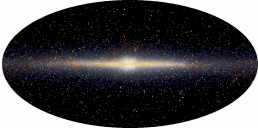In the previous scientific notation lab we
introduced the problem of calculating the number of protons in the
Milky Way galaxy, given that:
There are 200,000,000,000 stars in the Milky Way Galaxy.

A gram of hydrogen contains 600,000,000,000,000,000,000,000 protons.

A typical star (like our sun) contains
2,000,000,000,000,000,000,000,000,000,000,000 grams of hydrogen.

We learned that the multiplication big numbers like these numbers can be
simplified by the use of EXPONENTS, the first part of the scientific
notation scheme for representing large numbers:
| one hundred sextillion | = 100,000,000,000,000,000,000,000 |
| | = 1023 |
To complete our calculation of the number of protons in the galaxy
however, we need to account for the first digit of the large numbers
which may not always be equal to one (1).

Using the concept of the EXPONENT shown in the last lesson, can you
find a way to more quickly calculate the number of protons in the sun?
Can you calculate the number of protons in the Milky Way galaxy?
 Can you and your lab partner arrive at a scheme for dealing with
the first digit of large numbers in scientific notation?
Can you and your lab partner arrive at a scheme for dealing with
the first digit of large numbers in scientific notation?

What is the significance of the first digit?
- The first digit can be any numeral from 0 to 9.
- The relative sizes of two numbers with the same number
of zeros is simply proportional to the first digit. For
example, eight thousand (8,000) is four times as large as
two thousand (2,000), and eight (8) is four times as large
as two (2).

To the concept of an "Exponent" which we introduced in the last
lab [link to last lab] we now add the concept of a "Mantissa"
which represents the first nonzero digit(s) of a large number.
For example, we can write the number six hundred sextillion as:
| six hundred sextillion | = 600,000,000,000,000,000,000,000 |
| | = 6 x 1023 |
The numeral appearing in the superscript of the numeral 10
is the "exponent" of the number expressed in scientific notation.
The numeral appearing to the left of the multiplication sign is
the "Mantissa" of the number expressed in scientific notation.
In the following JAVA applets, you will again have a chance to practice
the conversion of numbers between conventional and scientific notation.

- To start: Enter a number in the two blanks next to "X 10". (please use 0 through 9 in the first blank, and 0 through 23 in the second one)
- Click the "Enter" button.
- Look at the information to see what the numbers you entered represent.
- Based on what you know from the first lab, can you figure out the relationship between scientific and standard notation?
- To see another number, click the "Clear" button and start over. Repeat multiple times until you think you have a good grasp of the numbers.


- To start: Look and see which one of the fields has been filled out for you (the text will be in black).
- Fill out the rest of the fields based on the field in black.
- When you've filled out all the fields, click the "Check It" button.
- Correct answers will remain in blue, while incorrect answers will turn red.
- If you got everything right, click the "New" button to try a new problem.
- If you got a part wrong, you can try the same problem again by clicking the "Try Again" button.
- Go through multiple problems. See if you can get every field correct for each type of question.
- Good luck!


Now we can return to the question which motivated this lesson:
How can we use this notation to simplify the manipulation of
large numbers?
- Does the scheme for expressing large numbers in terms of
mantissas and exponents suggest ways to simplify large
multiplications such as the number of protons in the galaxy?
- What relationship do you expect to find between the
exponents and mantissas in the expression
(A x 10N) x (B x 10M) = (C x 10X)
That is, can you find the relationships between N, M, and X?
A, B and C?

MULTIPLICATION AND DIVISION OF SCIENTIFIC NOTATION
Optionally, you may join Sherlock and Watson to solve a mystery,
just follow the link to the next applet which will explain
the rules for multiplication and division of numbers expressed in
scientific notation.

ANOTHER ADDITIONAL PROBLEM: What if the mantissa is decimal,
e.g. 6.02 x 1023???
|


